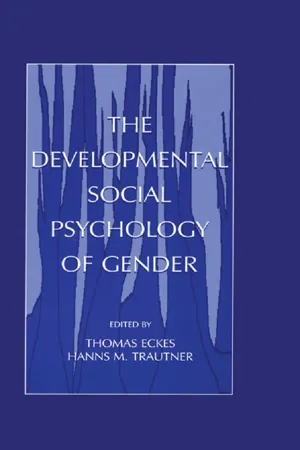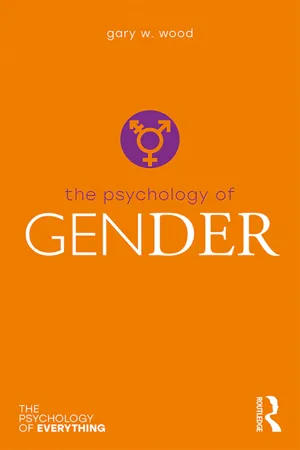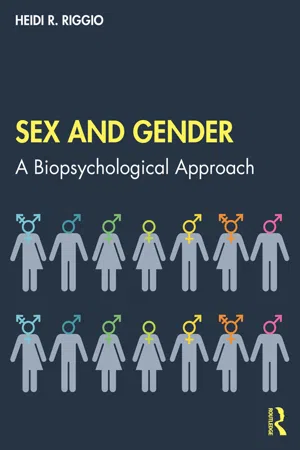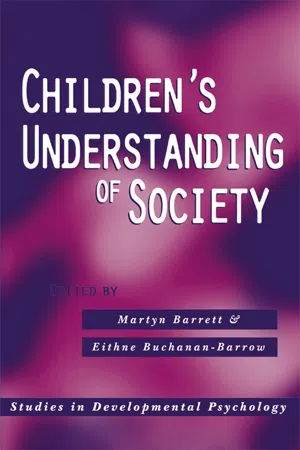Psychology
Gender Schema Theory
Gender Schema Theory proposes that children develop mental frameworks, or schemas, for understanding gender from an early age based on societal norms and expectations. These schemas influence how individuals perceive and behave in accordance with their gender. The theory suggests that these gender schemas can impact various aspects of cognition, including memory, attention, and decision-making.
Written by Perlego with AI-assistance
Related key terms
12 Key excerpts on "Gender Schema Theory"
- eBook - ePub
- Thomas Eckes, Hanns M. Trautner(Authors)
- 2012(Publication Date)
- Psychology Press(Publisher)
Hamilton, 1981 ). Social and developmental psychologists began to embrace the cognitive notions of schemas and scripts. Gender schemas were ideas whose time had come. Three groups of investigators independently developed versions of gender-schema theories in the early 1980s. These theories share common assumptions and themes but differ in emphasis.Schema theorists assume that individuals develop naive theories about gender and these theories influence the information individuals attend to, perceive, and remember. In a sense, this is a transactional processes in which the environment, which is highly organized by gender in most societies, leads to the creation of gender theories or schemas, which then promotes the gender-related processing of newly incoming information. In turn, these highly gender-focused theories then encourage the formation and continuation of gendered ideas by members of society through many levels of influence including the socialization of children. By having a highly gender-focused society, individuals are encouraged to create and interpret information through a gendered lens (Bem, 1993 ).The social psychological theory of gender schemas proposed by Bem (1981) remains a compelling account of how individuals’ beliefs and cognitions about the sexes and about themselves form around salient social categories, especially gender. Emphasis was placed on the functional significance of gender categories within our society. Gender is used broadly as a classification scheme in our culture: teachers line up children by sex, clothing cues mark the sexes of infants, and people respond to males and females differently. Because of its functional significance, children develop schemas about gender (see Bigler, Jones, & Lobliner, 1997 ). Furthermore, these schemas incorporate extensive networks of associations that go beyond the obvious associations with gender. Bem described, for instance, the metaphoric associations that individuals develop as part of gender schemas, such as soft things being feminine and rough things being masculine. Recent studies support this notion in that even children develop beliefs about softness and roundness being associated with females and hardness and angularity with males (Leinbach, Hort, & Fagot, 1997 - eBook - ePub
- Judith E. Owen Blakemore, Sheri A. Berenbaum, Lynn S. Liben(Authors)
- 2013(Publication Date)
- Psychology Press(Publisher)
gender schemata—their own attitudes and knowledge about gender—affect their interactions with, and processing of objects, people, or events in the world. Because gender schemata affect the child’s cognitive processes like perceiving, interpreting, or remembering gender-related material (i.e., gender-schematic processing), they have profound effects on developmental outcomes more generally. If, for example, gender-schematic processing leads a young girl to believe that all auto mechanics are men, she would then be unlikely, say, to engage in tool-related toy play or mechanical hobbies, unlikely to hang out with people in a workshop, unlikely to take certain courses in school. Ultimately she would not only have little chance of becoming an auto mechanic, but also of pursuing other educational and career opportunities that rely on tool use, mechanics, graphic diagrams, and so on. Thus, even though gender schemata themselves may seem to address relatively limited aspects of human behavior, their effects can be extremely far-reaching.Gender Schema Theory is part of a long tradition of constructive approaches to human behavior that have appeared not only in developmental psychology (e.g., Piagetian theory) but also in both social and cognitive psychology. In 1932, for example, Bartlett showed adults social stimuli (drawings of people or stories) and asked them repeatedly to draw or tell what they remembered after minutes, hours, weeks, and even months. When the drawings or stories depicted people and cultures that were strikingly unfamiliar to the participants, over successive attempts, the reproductions became less and less like the originals and more and more like people and stories that would normally be found in their own culture. These changes were thought to be due to the way in which new information is filtered through cognitive schemas. Bartlett showed that people had difficulty remembering materials that were culturally foreign, and that if they were able to remember the material at all, they were likely to distort the material so that it eventually became consistent with their own cultural knowledge and attitudes. - eBook - ePub
The Year in C-SPAN Archives Research
The Year in C-SPAN Archives Research, Volume 7
- Robert X. Browning(Author)
- 2021(Publication Date)
- Purdue University Press(Publisher)
Schemas can be understood as learned behaviors and structures of thought that are used by human beings to guide their perceptions of the world while helping them problem solve. These information-processing structures simplify daily cognition, as schemas create default assumptions in an effort to decrease deliberative cognition (DiMaggio, 1997). Schemas also can change and develop over the course of one’s lifetime as individuals face new obstacles and learn new information. Personal structures have their greatest impact on perceptions of others when making inferences about them without any context; however, the use of personal schema decreases once individuals focus on the actions and behaviors of the other individual because active cognition has been implemented (Catrambone & Markus, 1987). For example, because someone grew up being socialized that most women want to have children, they likely will assume that a woman they meet wants children someday, but as they get to know the woman better their assumption may be corrected. Interestingly, individuals also tend to recall inconsistent schema over consistent schema but recall consistent or inconsistent schema information better than neutral information (Hashtroudi et al., 1984). Similarly, political candidates who defy social norms are better remembered, but not necessarily better liked (Hayes, 2011).What Is Gender Schema?
Gender schema is one type of schema that is created through the process of individuals learning sex-related associations that both organize and guide the individual’s perception as they are faced with information that either agrees or disagrees with their current schema (Bem, 1981a). Sex-linked associations are largely a result of what society teaches individuals about the dichotomy between males and females and how these differences are applied to everyday life and situations. Individuals are usually considered sex-typed, which is when their sex and gender match cultural norms, cross-typed, when sex and gender match the opposite cultural norm, androgynous, when an individual shows characteristics of both genders and understands existing norms, or undifferentiated, when the individual has no understanding of gender norms and does not show an inclination to either gender (Bem, 1981a). Depending on the category that a particular person fits into, it affects their perception of gender roles in society. For example, if you are sex-typed, you are likely to see gender roles quite frequently, while if you are androgynous, you are unlikely to see them at all. The different perceptions of gender roles could affect the way that politicians are perceived. - eBook - ePub
Women's Lives
A Psychological Exploration, Fourth Edition
- Claire A. Etaugh, Judith S. Bridges(Authors)
- 2017(Publication Date)
- Routledge(Publisher)
EVALUATION. The concepts of cognitive developmental theory, like those of social learning theory, are clearly defined and easily measured and have generated considerable research. One key assumption of this perspective is that gender typing depends on an awareness of the unchangeability of gender. This assumption has received mixed support (Leaper & Farkas, 2014). Studies have shown that gender constancy precedes some, but not all, aspects of gender development (Bussey, 2013).A second assumption of cognitive developmental theory, that children value same-gender activities once they attain gender constancy, receives considerable support. Numerous studies show that children value their own gender more highly than they value the other gender (e.g., Martin et al., 2016).A major criticism of cognitive developmental theory is that it does not specify why children use gender as a classifying concept rather than other attributes such as race or eye color (Ryle, 2016).Gender Schema Theory
Gender Schema Theory, proposed by Sandra Bem (1993), incorporates elements of cognitive developmental and social learning theories. Like the first, it proposes that children develop an interrelated set of ideas, or schema, about gender that guides their social perceptions and actions. However, unlike cognitive developmental theory, Gender Schema Theory postulates that the use of gender as an organizing principle does not naturally stem from the minds of children. Similar to social learning theory, it assumes that gender schema development stems from learning the gender norms and practices of society.The theory proposes that children form notions of the traits and roles associated with females and males on the basis of societal expectations. They then use this information to regulate their own behavior, and their self-esteem becomes contingent on their adherence to these gender schemas.A significant difference between gender schema and cognitive developmental theories lies in the basis for gender schema development. Whereas Kohlberg (1966) assumes that the development of cognitive conceptualizations about gender is a natural process, Bem contends that children use gender to process social information because societal norms and practices emphasize its importance. Thus, children do not organize the social environment on the basis of physical attributes, such as handedness or hair color, because society does not give these characteristics the same significance it applies to gender. Bem argues that children cannot avoid noticing that different toys, activities, jobs, and chores are deemed acceptable for girls and boys by their parents, peers, and teachers. Elementary school teachers do not line up children separately by race because they do not want to emphasize race as a distinguishing characteristic. They often, however, group children by sex, thus increasing its perceived importance as a distinguishing characteristic. Indeed when preschool teachers make gender salient by doing such things as lining up children by gender and using gender-specific language (e.g., “I need a girl to hand out the markers”), children show increased gender stereotypes and decreased play with other-sex peers (Hilliard & Liben, 2010). - eBook - ePub
- Gary W. Wood(Author)
- 2018(Publication Date)
- Routledge(Publisher)
3Gender stereotypes and sex differences
The premise of ‘biological inevitability’ lends a sense of authenticity, naturalness or ‘realness’ to patterns of gender. We might even regard some people as ‘all man’ or ‘all woman’. Such idealized portraits are known as gender-role stereotypes – seemingly descriptive but often prescriptive. These ideals form the basis of many a best-selling, pop-psychology book on relationships. This chapter considers some of the psychological mechanisms (schema theory and attitudes) we employ to create and maintain gender-role stereotypes. These help to explain why black-and-white categories are so compelling. It goes on to examine research findings on psychological gender differences to ascertain whether we are worlds apart or all on the same page. Finally, the chapter sets the scene for discussing alternatives to the binary gender approach (later in the book) by considering the concept of androgyny.Making sense of the world
Two overlapping psychological concepts help to understand how we organize our knowledge of ourselves, others and the world: schemata and attitudes. They can be thought of as a form of human computer software – key procedures in our brain’s operating system.Schema theory
In a rapidly changing environment, it is impossible to process afresh every particle of information that impinges upon us every waking minute of every day. Our brains (and our heads) would need to be huge to accommodate the increased cognitive load. So how do our brains cope?We have a need to create an orderly world with governable rules. To achieve this, our pattern-seeking brain employs various routines and ‘rule-of-thumb’ (heuristic) shortcuts. Many situations, especially familiar ones, do not need sophisticated analysis, just automatic responses. A schema (plural schemata, sometimes schemas) is a mental structure of preconceived ideas representing some aspect of the world – a kind of ‘brain app’. As children, we actively construct a series of schemata based on social interactions, experiences and observations. These provide frameworks to organize existing knowledge and shape new experience. They focus our attention, filter our perceptions, shape memories and plug the gaps in our knowledge with their most-likely-default values. Schemata help us to forecast and predict likely events, assess threats, make decisions and regulate behaviour.1 - eBook - ePub
Sex and Gender
A Biopsychological Approach
- Heidi R. Riggio(Author)
- 2020(Publication Date)
- Routledge(Publisher)
Research indicates that some people are indeed gender schematic; they habitually use gender schemas (stereotypes, roles, etc.) to process information. For example, boys tend to rely more on gender stereotypes than girls in play activities (Eisenberg, Murray, & Hite, 1982), friendships (Zucker et al., 1995), toy preference (Turner, Gervai, & Hinde, 1993), and choice of gender role (Edelbrook & Sugawara, 1978), suggesting greater schematicity. Gender schematicity in girls and boys is associated with gender-congruent toy preference (Carter & Levy, 1988). Gender schematic adults tend to see themselves as highly representative of their gender and they tend to be rather traditional in their gender stereotypes and roles (Bem & Lenney, 1976). Other people are relatively gender aschematic; that is, they do not pay much attention to gender and do not rely heavily on gender stereotypes and roles to understand other people. These people are likely to be more androgynous (showing a mixture of typically feminine and masculine traits) in their own behavior (Schmitt & Millard, 1988).It is important to point out the difference between cognitive development theory and Gender Schema Theory. Cognitive development theory is more concerned about how gender identity develops and how that is reflected in children’s thoughts, feelings, and behaviors. Gender Schema Theory is more concerned with how gender schemas are used in processing social information, including one’s own gender identity. Schema theories explain that schematic processing is associated with automaticity, low effort. Schemas are easy to use and help process information very quickly, even instantly, according to a stereotype. An example is meeting a woman and instantly processing her in terms of gender stereotypes rather than other individuating information (e.g., she is Latina-American, she is a doctor, she is older; Signorella, Bigler, & Liben, 1993). As you recall from Chapter 5 , people use schemas when they are not motivated or able to process information carefully and thoroughly (Petty, - eBook - ePub
Technophobia
The Psychological Impact of Information Technology
- Mark J. Brosnan(Author)
- 2002(Publication Date)
- Routledge(Publisher)
Gender Schema Theory (Bem 1981b/c; 1983) contains features of both the cognitive development and the social learning accounts of sex-typing. Both Gender Schema Theory and cognitive development theory share a focus on individuals’ ‘active constructive cognitive process’ (Huston, 1983:400). Individuals are motivated to maintain a stable self-image consistent with the sex-differentiation that they see around them. In this way, sex-typed pattern of interests, attitudes and behavioural preferences are the consequence of this early categorization of the self and the world in sex-differentiated terms. Gender Schema Theory shares with social learning theory the emphasis upon a person’s acquisition of sex-distinctions that are present in the environment, as opposed to any direct biological determination.Thus, Gender Schema Theory proposes that sex-typing is a learned phenomenon that is mediated by the child’s own cognitive processing. Bem (1981b) describes a schema as a cognitive structure, a network of associations that organizes and guides an individual’s perception. A schema functions as an anticipatory structure, a readiness to search for and assimilate incoming information in schema-relevant terms. The phenomenon of sex-typing derives from gender based schematic processing, from a general readiness to process information on the basis of the sex-linked associations which constitute the gender schema. Specifically, the theory proposes that sex-typing results in part from the assimilation of the self-concept itself to the gender schema.Beliefs about one’s masculinity or femininity and about sex-linked attributes and behaviours become an important aspect of self-identity. Markus et al. (1982) assumed that in such cases ‘a gender schema is likely to be highly available and centrally implicated in information processing about gender in general and about the gender aspects of the self in particular’ (p. 39). Thus, Bem’s theory was founded on a conception of the sex-typed person as someone who has internalized society’s sex-typed standards of desirable behaviour for men and women.A sex-typed male, then, will demonstrate ‘masculine’ behaviours and repress ‘feminine’ behaviours; the opposite is true for sex-typed females. Individuals who do not orient their behaviour to that defined by society as appropriate for their biological sex are termed ‘androgynous’. This androgynous group does not include males who exhibit mainly feminine, and not masculine, behaviour or females who exhibit mainly masculine, not feminine, behaviour. This group is termed ‘cross-sex-typed’. Thus, androgynous individuals are those who have roughly equal levels of masculinity and femininity. - eBook - ePub
Women's Lives
A Psychological Exploration
- Claire A. Etaugh, Judith S. Bridges(Authors)
- 2023(Publication Date)
- Routledge(Publisher)
The concepts of cognitive developmental theory, like those of social learning theory, are clearly defined and easily measured and have generated considerable research. One key assumption of this perspective is that gender typing depends on an awareness of the unchangeability of gender. This assumption has received mixed support. Studies have shown that gender constancy precedes some, but not all, aspects of gender development (Endendijk et al., 2018 ; Riggio, 2021). A second assumption of cognitive developmental theory, that children value same-gender activities once they attain gender constancy, receives considerable support. Numerous studies show that children value their own gender more highly than they value the other gender (Endendijk et al., 2018). A major criticism of cognitive developmental theory is that it does not specify why children use gender as a classifying concept rather than other attributes such as race or eye color (Ryle, 2020). Gender Schema Theory Gender Schema Theory, proposed by Sandra Bem (1993), incorporates elements of cognitive developmental and social learning theories. Like the first, it proposes that children develop an interrelated set of ideas, or schema, about gender that guides their social perceptions and actions. However, unlike cognitive developmental theory, Gender Schema Theory postulates that the use of gender as an organizing principle does not naturally stem from the minds of children. Similar to social learning theory, it assumes that gender schema development stems from learning the gender norms and practices of society. The theory proposes that children form notions of the traits and roles associated with females and males on the basis of societal expectations - eBook - ePub
- Martyn Barrett, Eithne Buchanan-Barrow(Authors)
- 2004(Publication Date)
- Psychology Press(Publisher)
The Kohlberg (1966) account made a major contribution to the direction of gender role acquisition research by casting the fundamental question in a new light: not ``What do genes or society do to the child?'' but ``What does the child do with the information that society makes available?'' It also, as we have seen, inspired a large amount of fruitful empirical work that has enriched our understanding of the changes in the course of developing gender knowledge. However, one limitation of the account is that it attributes a great deal to the influence of gender constancy. Gender constancy is a relatively late achievement, and there is a lot of evidence that children behave in gender-specific ways from much earlier.This led Martin and Halverson (1981, 1987; Martin, 1991) to propose a new cognitive developmental theory, gender schematic processing theory. This theory accepts Kohlberg's emphasis on the organising of the child's active cognitive processing of gender information but maintains that the process begins much earlier, as soon as children discover their own gender identity. Once this is attained, children are motivated to learn more about what gender entails and they organise this information into gender schemas.Martin and Halverson distinguished two types of gender schemas: a superordinate structure, which contains broad information about the sexes, and an own-sex schema, which is more detailed. In common with other schema theories in cognitive psychology, the assumption is that the schemas operate to organise incoming data, to guide attention selectively, to underpin memory for relevant facts (as well as reject irrelevant or inconsistent data), and to bias behaviour and evaluations. For example, if one expects (has a gender schema that predicts) girls to play with dolls, then one tends to notice and recall instances of girls playing with dolls but occasional observations of girls playing with dragons or fire engines are not given much attention or are forgotten; also, if one is a girl, given a choice between dolls and dragons then the former is seen as the more natural option (that is, the gender schema guides behaviour).Martin and Halverson (1983) showed that 5- and 6-year-olds presented with sets of pictures of children performing either gender-consistent or gender-inconsistent activities subsequently recalled the pictures in line with gender stereotypes. Bradbard, Martin, Endsley, and Halverson (1986) found that 4- to 9-year-olds presented with sets of gender neutral toys that were labelled as ``for girls'' or ``for boys'' spent more time tactually exploring the toys labelled for their own sex and, 1 week later, remembered more detailed information about own-sex than other-sex objects. In an incidental exposure task, Cherney and Ryalls (1999) obtained superior memory for the identity and location of own-gender consistent objects among 3- and 6-year-olds. Levy (1999) found that children as young as 20 to 28 months showed preferential contact with own-sex toys. - (Author)
- 2015(Publication Date)
- Wiley(Publisher)
Although children commonly use gender concepts to guide encoding and interpretation of information, some children demonstrate gender-typed behaviors (e.g., play preferences) before the acquisition of a gender concept. Although this point has been used to discount the validity of Gender Schema Theory and cognitive-developmental theory (Bussey & Bandura, 1999), cognitive-developmental and gender schema theorists do not consider this problematic because they acknowledge that no single process or factor accounts for every facet of gender development (Martin et al., 2002). Consistent with this idea, allowing for both automatic and deliberate cognitive processes helps to explain more fully how cognitions influence gender development.Automatic cognitive processes can result from priming, conditioned associations, and habits. First, when the salience of gender is primed in the environment, children are more likely to use gender stereotypes to interpret events (see Bigler & Liben, 2006). Second, when certain attributes (e.g., traits, activities, roles) are repeatedly paired with a particular gender, children form semantic associations linking gender with the attributes. Positive or negative associations may be made if these associations additionally coincide with social approval and personal enjoyment or with social sanctions and displeasure, respectively. Third, when children themselves repeat certain actions, they can become scripts (e.g., Levy & Fivush, 1993) or procedural memories that are automatically engaged when prompted.The influence of automatic processing is further implicated in studies illustrating ways that children's gender schemas can bias information processing. For example, studies find children tend to distort their memories of previously observed counter-stereotypical events by recalling them as stereotypical (e.g., Martin & Halverson, 1983).As explained earlier, people's explicit and implicit gender beliefs sometimes differ (see Greenwald et al., 2002). For example, a person may consciously express nonstereotypical views when explicit measures are used, but the same person may demonstrate evidence of automatic gender stereotyping when implicit measures are applied. In one study, when school-age children's explicit and implicit gender stereotypes about math ability were assessed, some children who explicitly viewed girls and boys as equal in math ability additionally demonstrated implicit gender stereotypes associating math more with boys than girls (Cvencek, Meltzoff, & Greenwald, 2011). These findings imply that some persons may unconsciously internalize cultural gender stereotypes through repeated exposure despite consciously rejecting them.- eBook - ePub
- Penelope W. St J. Watson, Christine M. Rubie-Davies, Bernhard Ertl, Penelope W. St J. Watson, Christine M. Rubie-Davies, Bernhard Ertl(Authors)
- 2023(Publication Date)
- Routledge(Publisher)
The salience of gender, which can be influenced by both individual and environmental factors (Bigler & Liben, 2006), plays a role in both pathways. The attitudinal pathway describes the means by which a child’s gender schemas influence their own interests and behaviours. Under the attitudinal pathway model, when a child first encounters an object, person, or event (e.g., a toy, item of clothing, hairstyle, peer, school assignment, or extracurricular activity), the child first asks: Do I have a gender schema for this situation? For people or situations for which the child does not have a relevant gender schema, the individual evaluates whether the object, person, or event is of personal interest, and engages (or does not engage) accordingly. For people or situations in which a relevant gender schema is available, the individual then moves on to apply the gender schema filter. If the object, person, or event is viewed as for the other gender, it is ignored or avoided. If, instead, the object, person, or event is viewed as for one’s own gender, it can then progress to the interest filter to be evaluated for personal interest. Therefore, a gender schematic individual would not be expected to engage with every gender-typed activity or object, but would be expected to reject those that were not viewed as consistent with the own-gender schema. The personal pathway model, in contrast, is a self-to-other model in which children’s own interests, characteristics, and behaviours influence gender attitudes. In this model, the child first evaluates an object, person, or event through the filter of personal interest, asking: Do I like this? or Is this of interest to me? If the object, person, or event is of personal interest, the child then applies the gender salience filter. If the child is gender schematic, they will then be likely to project their own preferences and interests onto their gender ingroup (e.g., I like this toy, so other girls will also like it) - No longer available |Learn more
- John D. DeLamater, Jessica L. Collett(Authors)
- 2018(Publication Date)
- Routledge(Publisher)
Person schemas are cognitive structures that describe the personalities of others. Person schemas can apply either to specific individuals (such as Barack Obama, Lady Gaga, your father) or to types of individuals (such as introvert, class clown, sociopath). Person schemas organize our conceptions of others’ personalities and enable us to develop expectations about others’ behavior.Self-schemas are structures that organize our conception of our own characteristics (Markus, 1977, 1983). For instance, if you conceive of yourself as independent (as opposed to dependent), you may see yourself as individualistic, unconventional, and assertive. To behave in a manner consistent with your self-schema, you may refuse to accept money from your parents, refuse to ask others for help with schoolwork, take a part-time job, or dye your hair an unusual color. Self-schemas are discussed in detail in Chapter 4 .Group schemas —also called stereotypes—are schemas regarding the members of a particular social group or social category (Stangor & Schaller, 2000). Stereotypes indicate the attributes and behaviors considered typical of members of that group or social category. These are rigid conceptions and widely shared by members of a culture or community. American culture uses a wide variety of stereotypes about different races (Blacks, Asians), religious groups (Protestants, Catholics, Jews, Muslims), and ethnic groups (Arabs, Irish, Latinos, Italians).Role schemas indicate which attributes and behaviors are typical of persons occupying a particular role in a group. Chandra’s conception of the role of a congressional representative illustrates a role schema. Role schemas exist for most occupational roles—nurses, cab drivers, store managers, and the like—but they also exist for other kinds of roles in groups: group leader, captain of a sports team. Role schemas are often used to understand and predict the behaviors of people who occupy particular roles. For example, knowing that Russell Wilson is a quarterback gives us a good idea of what he will do during a football game.Event schemas (also called scripts
Index pages curate the most relevant extracts from our library of academic textbooks. They’ve been created using an in-house natural language model (NLM), each adding context and meaning to key research topics.











